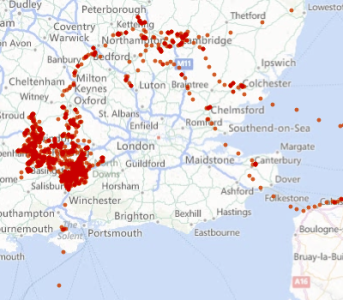The use of mathematical models to describe the motion of a variety of biological organisms has been the subject of much research interest for several decades. If we are able to predict the future locations of bacteria, cells or animals, and then we subsequently observe differences between the predictions and the experiments, we would have grounds to suggest that the local environment has changed, either on a chemical or protein scale, or on a larger scale, e.g. weather patterns or changing distributions of predators/prey.
Early approaches were predominantly centred on the position jump model of motion, where agents undergo instantaneous changes of position according to a distribution kernel interspersed with waiting periods of stochastic length. To clarify, after a random period of time, the organism in question disappears in one location, and reappears in another nearby location. Equations for the probability that a particle is located in a position in space are called drift-diffusion equations - which are usually easy to solve numerically.
However, the position jump framework suffers from the limitation that correlations in the direction of successive runs are difficult to capture; this directional persistence is present in many types of movement. Furthermore, the diffusive nature of the position jump framework results in an unbounded distribution of movement speeds between successive steps – so theoretically an animal could be moving at any speed! Consequently Oxford Mathematician Jake P. Taylor-King and colleagues have been looking at other ways to address the issue.
Some organisms, whose sizes can differ by many orders of magnitude, have been observed to switch between different modes of operation. For instance, the bacterium Escherichia coli changes the orientation of one or more of its flagella between clockwise and anticlockwise to achieve a run-and-tumble like motion. As a result, during the runs, we see migration-like movement and during the tumbles, we see resting or local diffusion behaviour. To add to this complexity, it should be noted that the direction of successive runs are correlated. On a larger scale let's compare the migratory movements of vertebrates where individuals often travel large distances with intermittent stop-overs to rest or forage. An example is the lesser black-backed gull (Larus fuscus). Individuals of this species that breed in the Netherlands migrate southwards during Autumn. Even though the scales involved in these two processes differ by many orders of magnitude, one can use the same mathematical framework to model the observed motion.
When considering the movement of a `particle’ as a series of straight-line trajectories, the corresponding mathematical description is known as a velocity jump process [Othmer 1988]. Organisms travel with a randomly-distributed speed and angle for a finite duration, before undergoing a stochastic reorientation event. A big hurdle when using this approach is that the underlying differential equation involves the use of mesoscopic transport equations that need to be solved in a higher dimensional space than traditional drift-diffusion equations. Until recently [Friedrich 2006], the length of jumps has been modelled as exponentially distributed for mathematical ease. Therefore, it is assumed there is a constant rate at which animals reorientate.
The researchers' new approach allows the specification of any running or waiting time distribution along with any angular and speed distributions. The resulting system of partial integro-differential equations are challenging to solve both analytically and numerically, and therefore it is necessary to both simplify and derive summary statistics.
For comparison between theory and experimental data, the researchers derived expressions for the mean squared displacement which shows good agreement with experimental data from the bacterium Escherichia coli and the gull Larus fuscus. A large time diffusive approximation is also considered via a Cattaneo approximation [Hillen 2004]. This leads to the novel result that the effective diffusion constant is dependent on the mean and variance of the running time distribution but only on the mean of the waiting time distribution. Therefore, two processes with the same means but different variances for how long an animal moves in the same direction can have different large scale observed behaviour.
Finally, this method then enables us to switch between straight-line trajectory GPS (or tracking) data and some of the commonly studied differential equation models used within mathematical ecology. The main benefit of this approach is that velocity jump models can often be parameterised using smaller quantities of data than what may be required when using a position jump process. All of which enables us to better predict the future locations of animals and, in turn, to better understand the reasons for the choice of those locations.
(the image above shows the pattern of seagulls above the UK).


